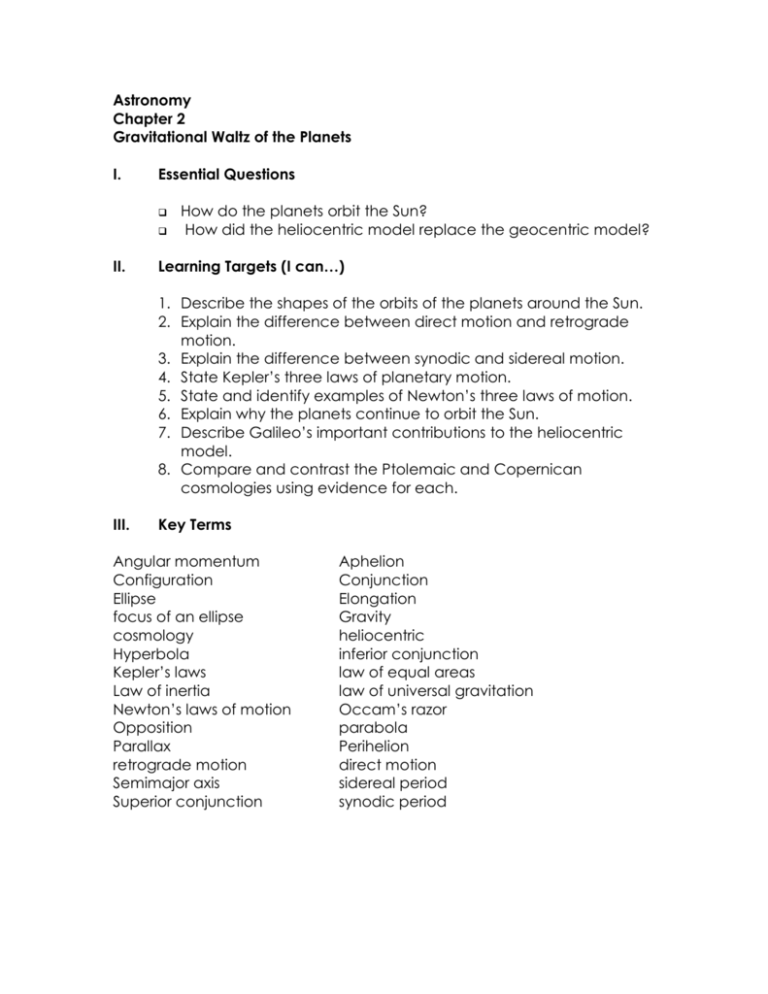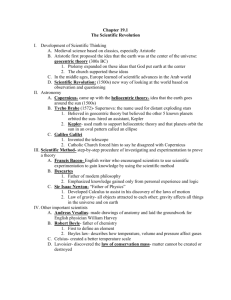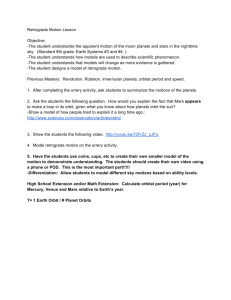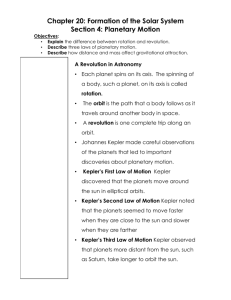Astronomy - Fort Thomas Independent Schools
advertisement

Astronomy Chapter 2 Gravitational Waltz of the Planets I. Essential Questions II. How do the planets orbit the Sun? How did the heliocentric model replace the geocentric model? Learning Targets (I can…) 1. Describe the shapes of the orbits of the planets around the Sun. 2. Explain the difference between direct motion and retrograde motion. 3. Explain the difference between synodic and sidereal motion. 4. State Kepler’s three laws of planetary motion. 5. State and identify examples of Newton’s three laws of motion. 6. Explain why the planets continue to orbit the Sun. 7. Describe Galileo’s important contributions to the heliocentric model. 8. Compare and contrast the Ptolemaic and Copernican cosmologies using evidence for each. III. Key Terms Angular momentum Configuration Ellipse focus of an ellipse cosmology Hyperbola Kepler’s laws Law of inertia Newton’s laws of motion Opposition Parallax retrograde motion Semimajor axis Superior conjunction Aphelion Conjunction Elongation Gravity heliocentric inferior conjunction law of equal areas law of universal gravitation Occam’s razor parabola Perihelion direct motion sidereal period synodic period IV. General Questions A. Motion of the Planets 1. 2. 3. 4. 5. 6. 7. 8. What are the planetary configurations and to which location does each refer? Explain the phases of Venus and change in its angular diameter as seen from Earth. What is the shape of the Earth’s orbit around the Sun? Do planets orbit the Sun at constant speeds? Do planets orbit the Sun at the same speed? How much force does it take to keep an object moving in a straight line at a constant speed? What are Kepler’s three laws of planetary motion? What was so significant about his findings? What is an ellipse? Newton’s three laws of motion, and Newton’s Universal law of gravitation, explain how and why the planets orbit the Sun. Look at the following table and answer the following questions. 9. 10. For which planet is the sidereal year the longest? The shortest? Explain why. What is the sidereal orbit for Venus and what is its synodic period? Explain why is there a difference. Why is the synodic period for Neptune very close to the length of the Earth year? Sidereal Period (year) Mercury 0.241 Venus 0.615 Earth 1 0.0748 Moon 1.881 Mars 1 Ceres 4.600 Jupiter 11.87 Saturn 29.45 Uranus 84.07 Neptune 164.9 248.1 Pluto Synodic Period (year) 0.317 1.599 — 0.0809 2.135 1.278 1.092 1.035 1.012 1.006 1.004 Synodic Period (days) 115.9 583.9 — 29.5306 780.0 466.7 398.9 378.1 369.7 367.5 366.7 "orbital period." The Columbia Electronic Encyclopedia, Sixth Edition. Columbia University Press., 2003. Answers.com 24 Oct. 2005. http://www.answers.com/topic/orbital-period B. Geocentric vs. Heliocentric Models 11. Explain the contribution to astronomy that each of the following made: Aristarchus Ptolemy Brahe Kepler 12. 13. Aristotle Copernicus Galileo Newton Compare and contrast the geocentric and heliocentric models. Why is the heliocentric model accepted today? What prevented the acceptance of the heliocentric model in the past? What is parallax and why is it important to the heliocentric model? Astronomy Chapter 2 Questions 1. Explain the contribution to astronomy that each of the following made: Pythagoras: He was the first to use mathematics to describe natural phenomena. Aristarchus: He was the first person noted to promote the heliocentric model of the universe. Aristotle: Major proponent of the geocentric model, thought the stars were fixed in a crystal sphere. Ptolemy: Wrote the Almagast, where he set forth the geocentric model in print. He used deferents and epicycles to explain the direct and retrograde motion of the planets as they orbited the Earth. Copernicus: Wrote the De Revolutionibus Orbium Coelestium, where he set forth the heliocentric model, indicating that Mercury and Venus are inside the Earth’s orbit of the Sun and that Mars, Jupiter and Saturn are outside the Earth’s orbit. Brahe: Amassed a huge collection of data regarding the position and motion of planets at his observatory Uranaborg. Galileo: First practical use of the telescope. Galileo’s observations added support to the heliocentric model. Galileo observed phases of Venus, four Moons orbiting Jupiter (not the Earth), sunspots and irregular surface of the Moon. These observations dispelled the notions of celestial perfection and that all planets and satellites orbit the Earth. Kepler: Using Brahe’s data, he correctly proved that planetary orbits are elliptical and not perfectly circular. He developed three laws to explain how the planets move, but not why. Newton: Wrote Principia and Optiks. Explained why the planets move by developing the universal law of gravitation (a force of attraction exists between all objects with mass) and three laws of motion (law of inertia, F = ma and for every action force there is an equal and opposite reaction force). Newton also explained that white light is composed of a series of colors, most easily recognized as roy g biv). 2. Compare and contrast the geocentric and heliocentric models. Why is the heliocentric model accepted today? What prevented the acceptance of the heliocentric model in the past? These models are only similar in that they attempt to explain the motion of the universe. Geocentric Model vs. Heliocentric Model All planets orbit the Earth Earth/planets orbit the Sun Direct and Retrograde motion of planets is explained using epicycles and deferents Direct and retrograde motion explained by orbit around Sun Planets orbit the Sun in perfect circles Planets orbit the Sun in ellipses Stars are fixed on a crystal sphere Equidistant from the Earth Stars are present at different distances as supported by parallax measurement The Earth does not move Newton’s laws of motion Indicated that we are moving but so is everything around us. Everything falls toward the Earth Gravity causes objects to be attracted to one other (you to Earth; Earth to Sun) All objects, even moons orbit the Earth Galileo’s observations of four moons of Jupiter and the phases of Venus indicate that objects orbit objects other than the Earth. The heliocentric model is accepted today because of observational evidence supported by mathematical predictions. The science (or our knowledge) has increased. Acceptance of the heliocentric model encountered technological boundaries which limited the understanding of the universe at that time. The telescope, mathematics, the printing press and the pursuit of knowledge via empirical methods led to new understandings. 3. What is parallax and why is it important to the heliocentric model? Parallax is the variation in angle between an object that is viewed from the Earth at different times. Parallax is important to the heliocentric model because according to the model, not every star is equidistant from Earth. The change in the parallax angle would indicate variable distances (the greater the angle, the closer the object). The parallax angle for stars cannot be viewed by the unaided eye. The telescope made it possible to measure this previously unseen angle or change. 4. What is the difference between kilometers, AU, light-years and parsecs? Which measure or measures is/are best for describing distances to stars and why? The difference is in the astronomical distance to be measured. Kilometers can be used for orbiting satellites and even the distance to the Moon. Astronomical units (or AU) are used to describe distances within the solar system. One AU is the average distance from the Earth to the Sun. Lightyears and the larger parsecs are much larger that kilometers. A light-year is the distance light travels in one year (in a vacuum). A parsec is 3.26 light years. Light-years or parsecs are distances used to describe stars beyond the reaches of the solar system. 5. Using Kepler’s three laws, Newton’s three laws of motion, and Newton’s Universal law of gravitation, explain how and why the planets orbit the Sun. Kepler’s first law: The orbit of a planet is an ellipse with the Sun at one focus. Kepler’s second law: A line joining a planet and the Sun sweeps out equal areas in equal intervals of time. Perihelion (closest to Sun) and aphelion (furthest from Sun) . A planet moves most rapidly when it is nearest the Sun and most slowly when it is farthest from the Sun. Kepler’s third law: The square of a planet’s sidereal period around the Sun is directly proportional to the cube of the length of its orbit’s semimajor axis. --Kepler determined that planets have elliptical orbits. --Kepler’s laws accurately described how planets move. --So, planets do not travel at constant speeds, do not orbit in circles and do not orbit the Sun at the same speed. --Most planets have a low eccentricity. 0 to 1 (0 is a circle, 1 is flat). --Kepler’s laws apply to all orbiting objects. Newton’s 1st law: There must be an outside force acting on planets to keep them from moving in a straight line (change direction and stay in orbit) Newton’s 3rd Law: Planets pulling on each other will pull with the equal and opposite force. Newton’s 2nd Law: Planets with the smaller mass will be more easily accelerated than the larger mass(F = ma) --The force required to cause the planets to orbit the Sun is called gravity (the force of attraction of one object to another). Newton universal law of gravitation: Two bodies attract each other with a force that is directly proportional to the product of their masses and inversely proportional to the square of the distance between them. --The speed of the orbiting planet is just fast enough to keep from falling into the Sun and just slow enough to keep from moving in a straight line (no escape velocity). --Newton’s precise description of the action gravity accounts for Kepler’s findings. It provides an explanation of why the planets orbit the Sun. 6. What is the difference between a superior and inferior orbit? What are the planetary configurations and to which location does each refer? --A superior planet is beyond the orbit of the Earth, an inferior planet is inside the Earth’s orbit. --Planetary configurations are the locations or geometric configurations of the planets with respect to the Sun and Earth. --Superior planets have conjunction and opposition --Inferior planets have inferior and superior conjunction, and greatest eastern and western elongation. 7. For which planet is the sidereal year the longest? The shortest? Explain why. Pluto has the longest sidereal year, Mercury has the shortest. This is because as the orbital path for planets increases away from the Sun, so will the time it takes for the planet to complete one orbit around the Sun. 8. What is the sidereal orbit for Venus and what is its synodic period? Explain why is there a difference. Why is the synodic period for Neptune very close to the length of the Earth year? Venus: sidereal orbit = .615 year synodic = 584 days It makes sense that Venus takes less time to orbit the Sun with respect to the stars that does the Earth. The synodic period represents the time it takes Venus to move from two successive identical configurations as viewed from the Earth, which is also orbiting the Sun. This causes the difference in days. The synodic period for Neptune is close to the length of an Earth year because relative to the time it takes Earth to orbit the Sun, Neptune moves only a small distance along its orbital path.






![Boom, Baroom, Baroom buraba [x2] - Newton-British](http://s3.studylib.net/store/data/007145924_1-a330d0f0b9b92fe6628107ec155c3345-300x300.png)

